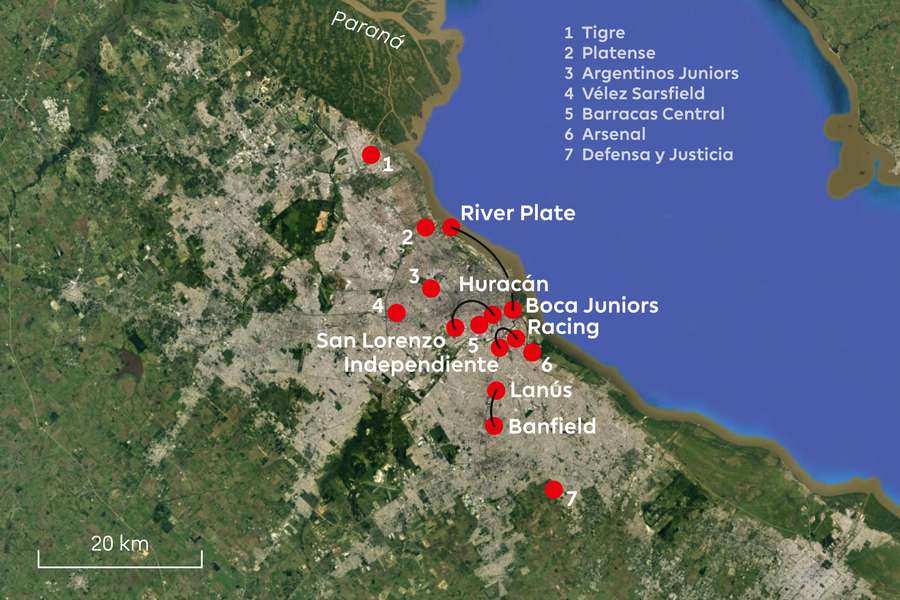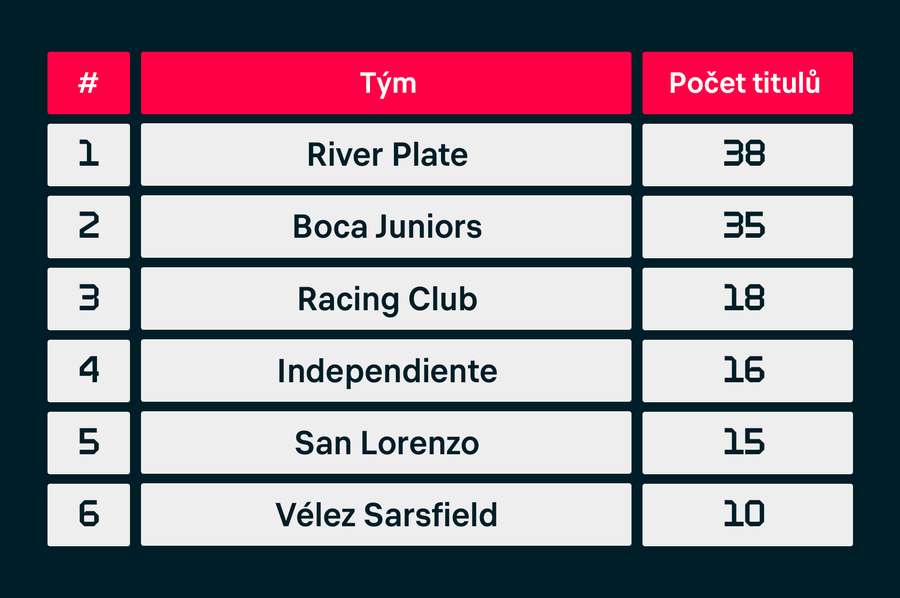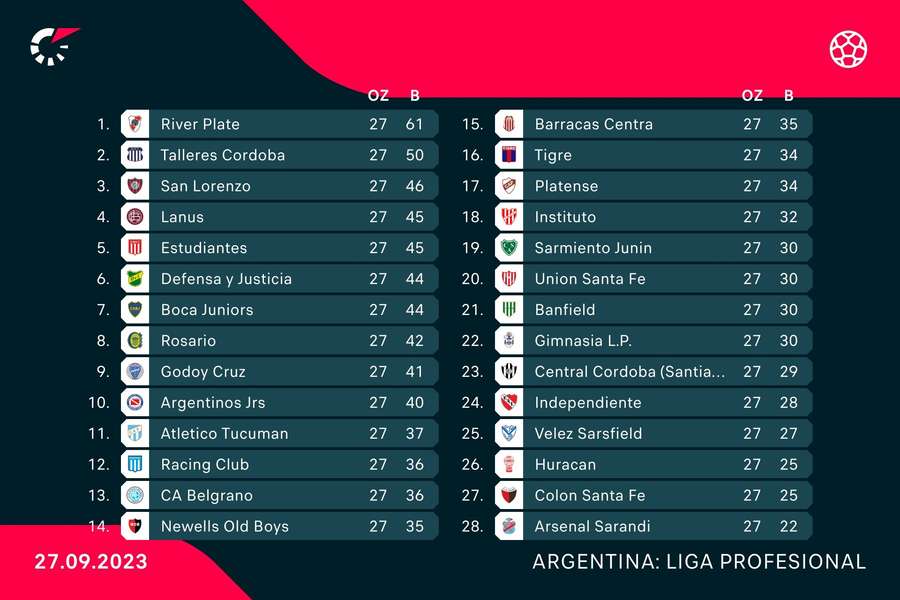Derby Week: Rivalries renewed as football fever grips Argentina

Football inflated in Buenos Aires
Argentina has 47 million inhabitants. Almost one-third of that is concentrated in the area that runs around the capital, Buenos Aires. "Greater Buenos Aires" (Gran Buenos Aires), as this metropolitan area is called, has swallowed up many other, formerly separate cities over time. Now the entire megalopolis is home to 15 million people.
Hand in hand with the concentration of population goes the sport that is clearly the most popular among Argentines. The Greater Buenos Aires is home to 15 clubs out of the 28-strong starting field of the first league, more than half. Moreover, Argentine football is sovereignly dominated by them too. All six of the most historically successful are based there.

Argentine football for fans
The concentration of as many derby matches as possible into a single round is of course no coincidence. The league's management wants to increase the spectator appeal of the local competition, the aim being to attract interest beyond the country's borders - there is certainly no shortage of fan interest at home. The special derby round of the Fecha de Clásicos is not the only thing the Argentine league has included in its marketing activities in recent years. Even the entire league system has changed.
Now, in the first part of the season (from January to July), the Primera División is played in a form where everyone plays everyone only once. As of 2023, there are 28 teams in the top competition. Thus, each club plays 27 matches in the league part of the season. This year, the champion of the Liga Profesional is River Plate.
In the second part of the season, the Copa de la Liga Profesional ("League Cup") follows the league part of the competition. The teams are divided into two groups of 14. Each plays all the opponents from its group (13 matches) plus one of the teams from the other. Groups A and B are divided so that each zone always contains one of the biggest rivalries in Argentine football.
The aim of the special "inter-zone" round is precisely a "Super Weekend" full of derbies, i.e. the most intense and exciting matches. After these 14 games, the top four from each zone will advance to the playoffs, in which the quarter-finals, semi-finals and final are played to a single deciding game.

Super Derby Weekend 2023
The series of derby matches kicks off on Saturday at 8pm with San Lorenzo playing Huracan, two clubs from Buenos Aires. Their mutual rivalry is referred to as the "Neighborhood Derby", sometimes as the Porteño derby.
Porteños (port people) is a slang term for a specific ethno-cultural group of people (not only) in Argentina, who are heavily concentrated in the southeastern part of the city (within the whole metropolis de facto in the centre - administratively right in Buenos Aires).
Another derby straight from the heart of Buenos Aires is the Clásico de Avellaneda (11pm), in which the country's third and fourth best clubs - Racing Club and Independiente - compete against each other.
Since 1928, the stadiums of the two local rivals have stood just 300 metres apart. Racing's stadium can hold 61,000 spectators, while Independiente's stand has a capacity of almost 49,000. A purely local rivalry is also the Clásico del Sur, a derby from the southern part of Greater Buenos Aires. The Banfield - Lanús match kicks off at 1.30am on Sunday.

The most important derby from outside the Greater Buenos Aires area is the Clasico Rosarino, the Rosario Central - Newell's Old Boys match (Saturday 8.30pm). Rosario, the birthplace of Lionel Messi (the famous Argentine started his football career at Newell's Old Boys), is 300km northwest of Buenos Aires. The two camps have been giving each other peppery nicknames since the 1920s.
These stem from events surrounding a match held to raise money and support a colony with leprosy. Rosario Central footballers refused to take part in the charity match at the time. Newell's Old Boys initiated the event. Therefore, the Rosario Central team and fans are forever "The Villains" (Canallas) and Newell's Old Boys are referred to as "The Lepers" (Leprosos) by rivals.
Rosario is the largest city in the province of Sante Fe, and the derby will also take place in the region's capital, Colón. The Colón Santa Fe - Union Santa Fe derby is scheduled to kick off at 9.30pm on Sunday. There will also be a derby for Argentina's second largest city, Cordoba (2.5 million inhabitants). The Clásico Cordobés is one of the oldest Argentine derbies.
The first match between Belgrano and Talleres took place in 1914. The next one starts on Sunday at 10.45pm. The seventh derby of the weekend is a clash between rivals from the city of La Plata, which lies to the south in close proximity to the Buenos Aires metropolitan area. The traditional Estudiantes - Gimnasia La Plata derby kicks off at 9pm.
The one derby that rules them all
The main event of the weekend, however, will undoubtedly be the Superclásico between two of the country's unequivocally best clubs. Boca Juniors - River Plate. The origins of both date back to the beginning of the 20th century in the Boca district of Buenos Aires. They first met in 1913.
Boca Juniors is considered the idol of the Argentine working class. River Plate has traditionally had supporters mainly in high society. It is also on this basis that the rivalry between Boca and River Plate divides the whole of Argentina.
Surveys of football fans in the country show that for 70% of all Argentines, one or the other of the clubs from the centre of Argentina's largest metropolis is the most popular. For many, teams from their own towns or neighbourhoods are second priority. The phenomenal stadiums of both rivals - the 54,000-seat La Bombonera and the 86,000-capacity Monumental - are bursting at the seams during the Superclasico.
In 2004, the traditional British Sunday newspaper The Observer included the Superclásico at the top of its list of experiences that every sports fan should experience in his or her lifetime.
The 260th overall derby between Boca Juniors and River Plate has kick-off at the famous La Bombonera stadium on Sunday at 6pm. The two rivals have an even record between them, both historically (91 Boca wins - 83 draws - 85 River Plate wins) and currently. During the previous four league editions, they have regularly alternated on the throne.
Of the past four derbies, each opponent has two wins. The most recent one so far, in May 2023, was decided by a penalty in the third minute of stoppage time in River Plate's favour. After that, the two teams had a melee on the pitch. The result was seven red cards and riots in the streets of the city.
However, in the Copa de la Liga Profesional, the new cup format for the second part of the season, the Boca Juniors are the more successful team so far. In 2020 and 2022, they won the first and third editions of the competition (in 2021, the Colón Santa Fe footballers enjoyed the title). Will River Plate follow up their 2023 league title with their first Copa de la Liga Profesional trophy? The points from the Superclasico will be very important to qualify for the next stage.
Derbies of the week
Thursday, September 28th
Belgium - Jupiler Pro League
RWD Molenbeek - Royale Union Saint-Gilloise
Zwanze derby (Brussels Humour Derby)
Until 2021, RWD Molenbeek and Royale Union Saint-Gilloise clashed in the second Belgian league. This season, they suddenly meet in the top competition. Brussels now has three clubs in the league (with Anderlecht). This derby is named after a typical Brussels humour called Zwanze.
Friday, September 29th
Portugal - Liga Portugal
O Clássico
Two of the country's biggest and most successful clubs face off in Portugal. Benfica, from the capital Lisbon, have won 85 championship titles, rivals Porto 84. It's not a typical derby match, but the rivalry between Benfica and FC Porto, as well as between Portugal's two biggest cities, is huge.
Saturday, September 30th
Spain - LaLiga
Real Sociedad - Athletic Bilbao
Derbi Vasco (Basque Derby)
Real Sociedad are based in San Sebastian, Athletic Club in Bilbao. These are the two most important and biggest cities and the two best clubs of the specific region of Basque Country in the north of Spain. The Basque Derby is a beautiful sporting and cultural event. Fans of both clubs routinely mingle with each other in the stadium.
Brazil - Serie A
Clássico majestoso (Majestic Clásico)
The derby between the two big teams from Sao Paulo - Sao Paulo and Corinthians - is called the Clássico majestoso. It is indeed a "majestic derby". This weekend will mark the 355th match between the two sides (Corinthians have won 131, Sao Paulo FC 109). It will be the fifth match between the two sides in 2023.
Sunday, October 1st
Wiener derby (Vienna derby)
For the last 10 seasons, Red Bull Salzburg have reigned supreme in Austrian football, but the two most successful clubs in terms of championship titles are still the two big brands from Vienna. The local derby between Rapid (32 titles) and Austria (24) is still the biggest match in Austria.
Croatia - HNL
Vječni derby (Eternal derby)
Dinamo Zagreb from the capital city clearly reigns supreme in Croatian football, historically and currently. Its biggest rival is Hajduk from the second biggest city - Split. Both clubs are backed by large and fanatical fan groups: the Bad Blue Boys (Dinamo) and Torcida (Hajduk).
Monday, October 2nd
France - Ligue 2
Derby Corse (Corsican derby)
The match between Ajaccio and Bastia is a clash between the two biggest clubs from the two biggest cities on the French island of Corsica. Ajaccio is its capital. The two rivals will face each other for only the fortieth time on Monday, as they have often passed each other in the past within the league system.

